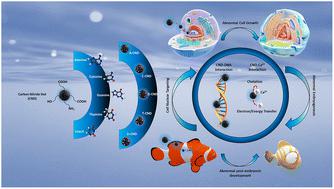Our official English website, www.x-mol.net, welcomes your
feedback! (Note: you will need to create a separate account there.)
An insight into embryogenesis interruption by carbon nitride dots: can they be nucleobase analogs?
Nanoscale ( IF 5.8 ) Pub Date : 2022-11-17 , DOI: 10.1039/d2nr04778k Yiqun Zhou 1, 2, 3 , Jiuyan Chen 1 , Emel Kirbas Cilingir 1 , Wei Zhang 1 , Lemay Gonzalez 4 , Samuel Perez 4 , Arjuna Davila 4 , Nicholas Brejcha 4 , Jun Gu 1 , Wenquan Shi 5 , Justin B Domena 1 , Braulio C L B Ferreira 1 , Fuwu Zhang 1 , Frederic A Vallejo 6 , Daniela Toledo 1 , Piumi Y Liyanage 7 , Regina M Graham 6 , Julia Dallman 8 , Zhili Peng 5 , Christian Agatemor 1, 9 , Alessandro Catenazzi 3 , Roger M Leblanc 1
Nanoscale ( IF 5.8 ) Pub Date : 2022-11-17 , DOI: 10.1039/d2nr04778k Yiqun Zhou 1, 2, 3 , Jiuyan Chen 1 , Emel Kirbas Cilingir 1 , Wei Zhang 1 , Lemay Gonzalez 4 , Samuel Perez 4 , Arjuna Davila 4 , Nicholas Brejcha 4 , Jun Gu 1 , Wenquan Shi 5 , Justin B Domena 1 , Braulio C L B Ferreira 1 , Fuwu Zhang 1 , Frederic A Vallejo 6 , Daniela Toledo 1 , Piumi Y Liyanage 7 , Regina M Graham 6 , Julia Dallman 8 , Zhili Peng 5 , Christian Agatemor 1, 9 , Alessandro Catenazzi 3 , Roger M Leblanc 1
Affiliation

|
The carbon nitride dot (CND) is an emerging carbon-based nanomaterial. It possesses rich surface functional moieties and a carbon nitride core. Spectroscopic data have demonstrated the analogy between CNDs and cytosine/uracil. Recently, it was found that CNDs could interrupt the normal embryogenesis of zebrafish. Modifying CNDs with various nucleobases, especially cytosine, further decreased embryo viability and increased deformities. Physicochemical property characterization demonstrated that adenine- and cytosine-incorporated CNDs are similar but different from guanine-, thymine- and uracil-incorporated CNDs in many properties, morphology, and structure. To investigate the embryogenesis interruption at the cellular level, bare and different nucleobase-incorporated CNDs were applied to normal and cancerous cell lines. A dose-dependent decline was observed in the viability of normal and cancerous cells incubated with cytosine-incorporated CNDs, which matched results from the zebrafish embryogenesis experiment. In addition, nucleobase-incorporated CNDs were observed to enter cell nuclei, demonstrating a possibility of CND–DNA interactions. CNDs modified by complementary nucleobases could bind each other via hydrogen bonds, which suggests nucleobase-incorporated CNDs can potentially bind the complementary nucleobases in a DNA double helix. Nonetheless, neither bare nor nucleobase-incorporated CNDs were observed to intervene in the amplification of the zebrafish polymerase-alpha 1 gene in quantitative polymerase chain reactions. Thus, in conclusion, the embryogenesis interruption by bare and nucleobase-incorporated CNDs might not be a consequence of CND–DNA interactions during DNA replication. Instead, CND–Ca2+ interactions offer a plausible mechanism that hindered cell proliferation and zebrafish embryogenesis originating from disturbed Ca2+ homeostasis by CNDs. Eventually, the hypothesis that raw or nucleobase-incorporated CNDs can be nucleobase analogs proved to be invalid.
中文翻译:

深入了解氮化碳点对胚胎发生的干扰:它们可以是核碱基类似物吗?
氮化碳点(CND)是一种新兴的碳基纳米材料。它具有丰富的表面功能部分和氮化碳核心。光谱数据证明了 CND 和胞嘧啶/尿嘧啶之间的类比。最近,发现 CNDs 可以中断斑马鱼的正常胚胎发生。用各种核碱基(尤其是胞嘧啶)修饰 CND 会进一步降低胚胎活力并增加畸形。理化性质表征表明,掺入腺嘌呤和胞嘧啶的 CND 在许多性质、形态和结构上与掺入鸟嘌呤、胸腺嘧啶和尿嘧啶的 CND 相似但不同。为了研究细胞水平的胚胎发生中断,将裸和不同的掺入核碱基的 CND 应用于正常和癌细胞系。在用胞嘧啶掺入的 CND 孵育的正常细胞和癌细胞中观察到剂量依赖性下降,这与斑马鱼胚胎发生实验的结果相符。此外,观察到掺入核碱基的 CND 进入细胞核,证明了 CND-DNA 相互作用的可能性。互补核碱基修饰的 CND 可以相互结合通过氢键,这表明掺入核碱基的 CND 可以潜在地结合 DNA 双螺旋中的互补核碱基。尽管如此,在定量聚合酶链反应中,未观察到裸 CND 或掺有核碱基的 CND 会干预斑马鱼聚合酶-α 1 基因的扩增。因此,总而言之,裸露的和掺入核碱基的 CND 对胚胎发生的中断可能不是 DNA 复制过程中 CND-DNA 相互作用的结果。相反,CND–Ca 2+相互作用提供了一种可能的机制,该机制阻碍了细胞增殖和斑马鱼胚胎发生,这些胚胎发生源自受干扰的 Ca 2+CND 的体内平衡。最终,原始或掺入核碱基的 CND 可以是核碱基类似物的假设被证明是无效的。
更新日期:2022-11-22
中文翻译:

深入了解氮化碳点对胚胎发生的干扰:它们可以是核碱基类似物吗?
氮化碳点(CND)是一种新兴的碳基纳米材料。它具有丰富的表面功能部分和氮化碳核心。光谱数据证明了 CND 和胞嘧啶/尿嘧啶之间的类比。最近,发现 CNDs 可以中断斑马鱼的正常胚胎发生。用各种核碱基(尤其是胞嘧啶)修饰 CND 会进一步降低胚胎活力并增加畸形。理化性质表征表明,掺入腺嘌呤和胞嘧啶的 CND 在许多性质、形态和结构上与掺入鸟嘌呤、胸腺嘧啶和尿嘧啶的 CND 相似但不同。为了研究细胞水平的胚胎发生中断,将裸和不同的掺入核碱基的 CND 应用于正常和癌细胞系。在用胞嘧啶掺入的 CND 孵育的正常细胞和癌细胞中观察到剂量依赖性下降,这与斑马鱼胚胎发生实验的结果相符。此外,观察到掺入核碱基的 CND 进入细胞核,证明了 CND-DNA 相互作用的可能性。互补核碱基修饰的 CND 可以相互结合通过氢键,这表明掺入核碱基的 CND 可以潜在地结合 DNA 双螺旋中的互补核碱基。尽管如此,在定量聚合酶链反应中,未观察到裸 CND 或掺有核碱基的 CND 会干预斑马鱼聚合酶-α 1 基因的扩增。因此,总而言之,裸露的和掺入核碱基的 CND 对胚胎发生的中断可能不是 DNA 复制过程中 CND-DNA 相互作用的结果。相反,CND–Ca 2+相互作用提供了一种可能的机制,该机制阻碍了细胞增殖和斑马鱼胚胎发生,这些胚胎发生源自受干扰的 Ca 2+CND 的体内平衡。最终,原始或掺入核碱基的 CND 可以是核碱基类似物的假设被证明是无效的。











































 京公网安备 11010802027423号
京公网安备 11010802027423号